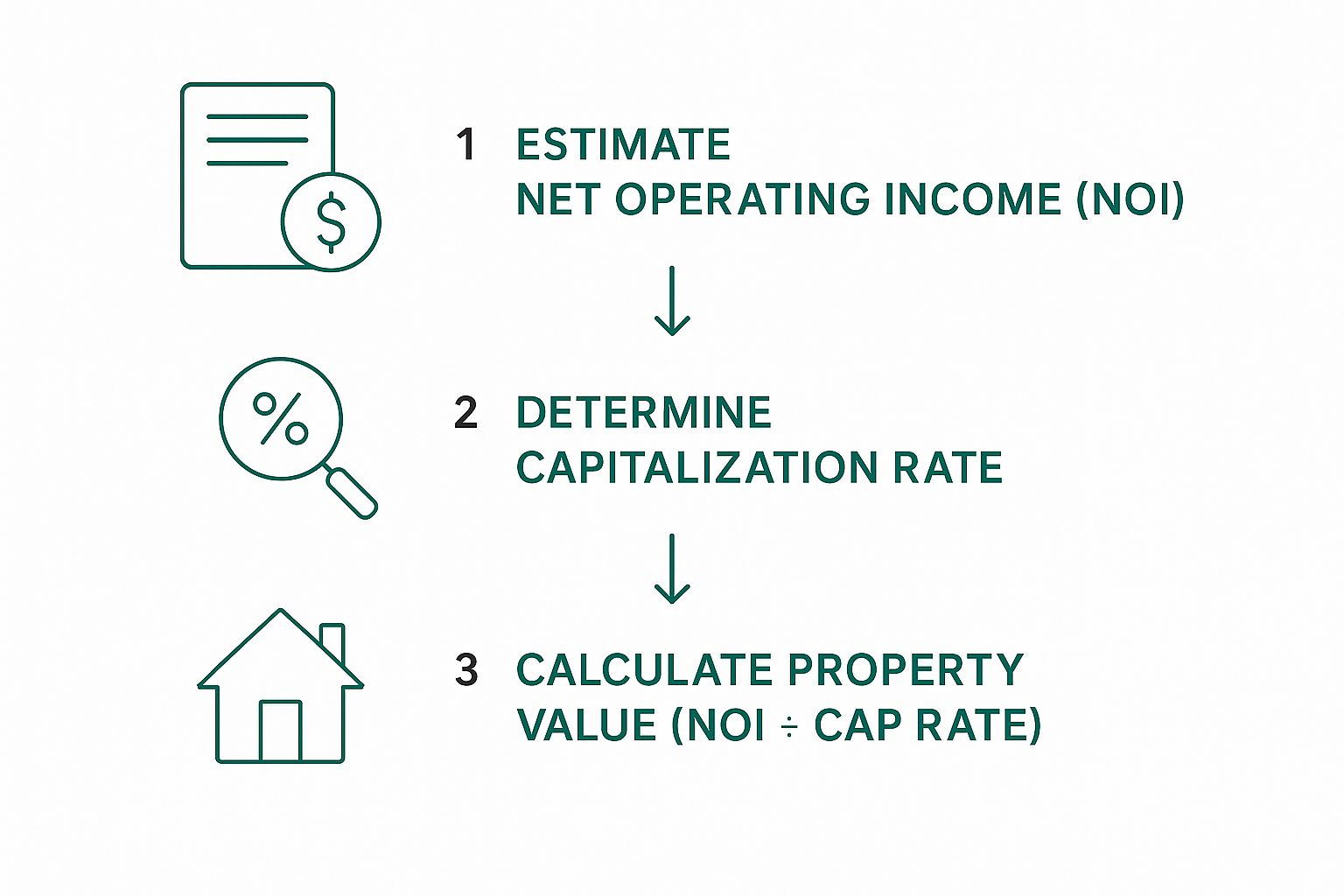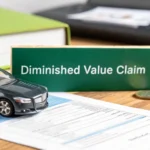Learning how to calculate fair market value for your car after an accident is the most important step toward getting a fair settlement from your insurance company. Getting a lowball offer can be incredibly frustrating, but understanding FMV empowers you to fight for the compensation you deserve.
What Fair Market Value Means for Your Insurance Claim

Fair Market Value is the foundation of any total loss settlement. In simple terms, it’s the price a willing buyer would pay a willing seller for your car, assuming both parties know its condition and neither is in a rush. This is the amount your insurance company should pay you to replace your vehicle.
Why Insurance Company Valuations Often Fall Short
Insurance companies are businesses, and their goal is often to minimize claim payouts. The valuation reports they use can pull data that conveniently undervalues your vehicle or ignores your local market conditions.
Here are common tactics they use:
- Using outdated sales data: The used car market changes quickly. Data from a few months ago can dramatically undervalue your car today.
- Cherry-picking poor “comps”: They might compare your well-maintained vehicle to examples with higher mileage, fewer options, or from a cheaper market to justify a low offer.
- Ignoring special features: That premium sound system, rare trim package, or your perfect maintenance history? Automated systems almost always overlook these valuable details.
This is why accepting the insurer’s first offer can cost you thousands. That number isn’t final—it’s just their opening bid in a negotiation. If you want to dive deeper, you can explore the key insights and definitions of Fair Market Value.
Your vehicle’s value isn’t just about its make and model. It’s a combination of its exact condition, mileage, options, and what buyers are willing to pay for it in your area. To get a fair payout, you need to take control of the valuation process.
The Power of an Independent Appraisal
Gathering your own market data is a great start, but getting an adjuster to take it seriously is another battle. They are often trained to dismiss research provided by vehicle owners. This is where a certified, independent appraisal from a service like SnapClaim becomes your most powerful tool.
Our reports deliver the objective, data-driven proof needed to challenge a lowball offer and support your negotiations with the insurer. We are so confident in our ability to help that we offer a money-back guarantee: if the insurance recovery from your claim is less than $1,000, your appraisal fee is fully refunded. This makes getting an expert valuation a risk-free step toward securing the fair settlement you are owed.
Building Your Case: How to Prove Your Vehicle’s Real Value
Think of yourself as a detective building a case for your car’s true worth. Your goal is to gather every piece of evidence that tells its story, making it difficult for an insurance adjuster to undervalue your claim. This is about painting a complete picture of your car’s pre-accident condition, its history, and the unique features that set it apart.
Start with the Basics: Your Vehicle’s Identity
Every valuation starts with the fundamentals. These documents establish exactly what car is being valued.
- Vehicle Identification Number (VIN): This is your car’s unique fingerprint. The VIN unlocks its factory specs, from the exact trim level to every optional feature.
- Original Window Sticker (Monroney Label): If you can find this, it’s a goldmine. It lists every factory-installed option and package—like a premium sound system or towing package—that generic valuation tools almost always miss.
Having this information ready prevents the insurer from comparing your fully-loaded vehicle to a stripped-down base model to justify a low offer.
Show a History of Meticulous Care
This is where you can significantly boost your car’s value. A vehicle with a detailed service history is worth much more than one with a questionable past.
Dig up every receipt and record you can find for:
- Regular oil changes
- Tire rotations and replacements (especially recent, high-quality tires)
- Brake jobs and component replacements
- Major services, like a new timing belt or transmission work
Each document proves you invested in the vehicle’s health and reliability, which supports a higher fair market value.
A thick folder of maintenance records tells a powerful story. It says, “This wasn’t just any car; this was a well-cared-for vehicle.” That story is worth real money in a total loss negotiation.
Use Visual Proof of Pre-Accident Condition
Photos and videos are incredibly persuasive. You need to show the adjuster what they can no longer see: the excellent condition of your car right before the accident.
Scour your phone, social media, and cloud backups for any clear images of your car. Look for shots that show off the paint, the spotless interior, and its overall clean appearance. These images are your best defense against an insurer trying to claim your vehicle had “pre-existing damage.”
When you combine this detailed documentation with a professional valuation, your case becomes undeniable. To see how experts put it all together, check out our in-depth certified auto appraisal guide.
How to Find Your Vehicle’s Baseline Value

With your evidence organized, it’s time to find the actual number. The most credible way to calculate fair market value is by using the sales comparison method. This approach relies on real-world market data, not just abstract formulas. The goal is to find several “comps”—comparable vehicles that have recently sold in your local area—to prove what a real buyer would have paid for a car just like yours.
Mastering the Search for Comps
To find solid comps, you’ll need to search the major online vehicle marketplaces. Websites like AutoTrader, Cars.com, and even Facebook Marketplace are full of data if you know how to filter them effectively.
Here’s how to narrow your search for the most accurate results:
- Exact Make, Model, and Year: This is non-negotiable. A 2021 model is not the same as a 2020.
- Trim Level: This is crucial. A base model is worth significantly less than a fully-loaded trim.
- Mileage: Filter your search to within 10-15% of your vehicle’s mileage at the time of the loss.
- Location: Stick to your local market—a 50 to 75-mile radius is a good rule of thumb. A truck in Texas has a different market value than the same truck in New York.
Applying these filters ensures your comps are truly comparable, making your final valuation much harder for an adjuster to argue with.
Using KBB and NADA Guides Correctly
You’ve probably already looked up your car on Kelley Blue Book (KBB) or NADAguides. These online tools are a decent starting point, but it’s crucial to understand their limitations in an insurance claim negotiation.
These guides provide generalized values based on national averages. They often fail to capture the specific nuances of your local market or your vehicle’s unique condition and options. An adjuster might point to a low KBB value, but that number doesn’t reflect what real buyers in your area are actually paying. You can learn more in our detailed analysis of the Kelley Blue Book diminished value calculator and its role in claims.
Pro Tip: Use KBB and NADA as a preliminary reference, but never let them be the final word. The strongest proof of your car’s value comes from actual, local vehicle listings.
An Overview of Valuation Resources
Different tools serve different purposes. While online guides give you a quick snapshot, they lack the specificity needed for a formal insurance claim. Here’s a quick breakdown of common resources.
Key Valuation Resources and Their Roles
| Resource | Best Use Case | Potential Limitation |
|---|---|---|
| KBB / NADAguides | Quick, initial ballpark estimate. | Based on national averages; may not reflect local market conditions or specific vehicle features. |
| Online Marketplaces (AutoTrader, etc.) | Finding real, local “comps” to establish a data-driven baseline value. | Requires careful filtering; asking prices aren’t always selling prices. |
| Dealer Quotes | Getting a trade-in or retail price perspective. | Often biased toward the dealer’s interests (low on trade-in, high on retail). |
| Certified Appraisals | Formal, independent valuation for insurance claims and legal disputes. | Involves a professional fee but provides the strongest, most credible evidence. |
Putting the Sales Comparison Method to Work
As you gather your comps, save screenshots or PDFs of each listing. Your goal should be to find at least three to five strong examples.
For each one, document the following details:
- Asking Price
- Year, Make, Model, and Trim
- Mileage
- VIN (if available)
- Listed options and features
- Overall condition from the listing
This collection of real-world data is the foundation of your claim. It shifts the conversation from the insurer’s generic report to an evidence-based discussion about what it would actually cost to replace your vehicle in your local market.
Adjusting for Condition, Mileage, and Options
Finding a baseline value using comparable sales is a huge step. But since no two used cars are identical, you need to adjust that value based on your car’s specific details. This is the key to calculating its true fair market value and is where you can add hundreds or even thousands of dollars to your settlement.
Honestly Grading Your Car’s Pre-Accident Condition
First, be honest about your vehicle’s condition before the crash. Insurance adjusters will often try to downgrade your car’s condition to justify a lower payout.
Most valuation systems use a simple grading scale:
- Excellent: Looked brand new. Flawless paint, spotless interior, everything worked perfectly. This is a very high bar for a used car.
- Good: Minor cosmetic blemishes (small scratches or dings) but free of any real issues. Clean interior with minimal wear and mechanically sound. Most well-cared-for daily drivers fall here.
- Fair: Noticeable flaws like visible dents, faded paint, or seat stains. May have needed minor mechanical fixes but was still reliable.
- Poor: Significant mechanical problems, visible body rust, or a heavily worn interior.
Be honest with yourself and use your pre-accident photos to back up your assessment. If your car was in “Good” condition, don’t let an adjuster label it “Fair” without providing proof.
Calculating Adjustments for Mileage
Mileage is one of the biggest factors in a car’s value. A vehicle with lower-than-average mileage for its age is almost always worth more. The industry standard is typically between 12,000 to 15,000 miles per year.
To make an adjustment, compare your car’s mileage to the average of your comps. If your car has significantly fewer miles, it deserves a positive adjustment. A common practice is to assign a value per mile—something like $0.15 to $0.40 per mile, depending on the car’s age and class.
Example: The average mileage for your comps is 80,000 miles, but your car only had 60,000. That’s a 20,000-mile difference. At an adjustment rate of $0.25 per mile, that adds a solid $5,000 to your vehicle’s fair market value (20,000 miles x $0.25).

Accounting for Every Option and Upgrade
Factory-installed options and recent major repairs are huge value-adds that automated insurance reports almost always miss. Create a detailed list of every feature that made your car more valuable.
Go through this checklist:
- Premium Packages: Did it have a technology package, a towing package, or a luxury interior group?
- Desirable Options: Sunroof, leather seats, a premium sound system, or an advanced navigation system all increase value.
- Recent Major Maintenance: Have you invested in the car recently? New tires, a new battery, or a recent brake job are powerful arguments for a higher value.
For each item, try to find what it adds to the retail value by comparing comps with and without those features. Showing you recently spent $1,200 on new tires is tangible proof your vehicle was worth more. These details are also key when trying to figure out how much an accident will devalue a car in a diminished value claim.
Putting all these adjustments together gives you a highly accurate and defensible final number. This detailed approach is precisely what we do at SnapClaim, providing the proof needed to support your negotiations.
Presenting Your Fair Market Value to the Insurer

You’ve done the research and built a logical, well-supported case for your vehicle’s value. Now it’s time to take your final, defensible number back to the insurance adjuster. This is where your hard work becomes your most powerful negotiation tool.
Calculating Your Final FMV Number
The most credible way to determine your final Fair Market Value (FMV) is to average the adjusted values of your best comps. After applying tweaks for mileage, condition, and options to each comparable vehicle, you’ll have a list of refined values.
Let’s walk through an example. Your car was a 2019 Toyota RAV4 XLE with 65,000 miles. You found three strong local comps:
- Comp 1: Asking price of $25,500 with 75,000 miles. Your lower mileage is an advantage, so you add a $2,500 positive adjustment. Adjusted Value: $28,000.
- Comp 2: Listed at $26,000 with 68,000 miles. It’s close, but yours had the premium sound system, which this one lacks. You add a $750 options adjustment. Adjusted Value: $26,750.
- Comp 3: Priced at $27,000 with 60,000 miles. This comp has better mileage, so you apply a negative adjustment of -$1,250. Adjusted Value: $25,750.
Now, average those three adjusted values: ($28,000 + $26,750 + $25,750) ÷ 3 = $26,833
This final figure, $26,833, is your data-driven Fair Market Value, backed by what’s happening in your local market.
The Challenge of DIY Valuations
Presenting your own calculated FMV is a critical step, but be ready for pushback. This can be especially true in complex cases like natural disaster insurance claims. Even with meticulous research, adjusters are trained to dismiss valuations from vehicle owners. They might say your comps aren’t valid or that their “professional” report is the only one that counts. This is a standard tactic designed to wear you down.
An insurance adjuster’s primary job is to close claims for the lowest amount possible. Your detailed research is a fantastic start, but they will almost always favor their own biased data over yours.
Why a Certified Appraisal Is Your Strongest Move
When an adjuster refuses to negotiate based on your research, a certified, independent appraisal is your best next step. A professional report from a service like SnapClaim translates your hard work into an official language the insurance industry is forced to respect. It provides the official documentation needed to fortify your claim and challenge a low offer.
Our appraisers conduct a thorough market analysis, document every value-adding feature, and present the findings in a format that adjusters can’t easily dismiss. When the evidence comes from a certified third party, it carries far more weight. A certified report can be the one thing that helps you recover thousands more than the insurer initially offered.
At SnapClaim, we stand by our certified reports with a straightforward money-back guarantee. If our appraisal doesn’t help you recover at least $1,000 more from the insurance company, we will refund your appraisal fee in full. This makes getting expert help a risk-free step toward securing the compensation you are owed.
Frequently Asked Questions About Vehicle Value
Here are straightforward answers to common questions vehicle owners have about fair market value.
How is Fair Market Value different from trade-in value?
This is a critical distinction. Fair Market Value (FMV) is the price your car would sell for in a private sale to another person. This is the standard insurance companies are supposed to use for a total loss. Trade-in value is the lower, wholesale price a dealership offers you. Insurers may try to use this lower number, but you are owed the amount it would cost to replace your vehicle in your local market, which is the FMV.
What if the insurer’s valuation report seems wrong?
Trust your gut. Insurers often use third-party services that pull comps from outside your local market or use outdated sales data to justify a lowball offer. If their report feels off, it’s time to push back with your own research. If the adjuster still won’t negotiate, a certified appraisal is your best tool to prove your vehicle’s true worth. For more tips, read our guide on how to deal with insurance adjusters.
Does my total loss settlement include sales tax and fees?
In most states, yes. Your settlement should make you “whole” again, which includes covering the necessary costs to buy a replacement car, such as sales tax, title, and registration fees. However, rules vary by state and policy. It’s always a good idea to check your state’s regulations. The U.S. consumer advocacy site NOLO provides helpful state-by-state information on this topic.
What if I get an appraisal and don’t recover more money?
We understand that investing in an appraisal can feel like a risk when you’re already dealing with a financial loss. That’s why we created our money-back guarantee to make the process completely risk-free for you. If the insurance recovery from using our certified appraisal is less than $1,000 above the insurer’s offer, we will refund your appraisal fee in full. This ensures getting professional help is a no-lose situation.
About SnapClaim
SnapClaim is a premier provider of expert diminished value and total loss appraisals. Our mission is to equip vehicle owners with clear, data-driven evidence to recover the full financial loss after an accident. Using advanced market analysis and industry expertise, we deliver accurate, defensible reports that help you negotiate confidently with insurance companies.
With a strong commitment to transparency and customer success, SnapClaim streamlines the claim process so you receive the compensation you rightfully deserve. Thousands of reports have been delivered to vehicle owners and law firms nationwide, with an average of $6,000+ in additional recovery per claim.
Why Trust This Guide
This article was reviewed by SnapClaim’s team of certified auto appraisers and claim specialists with years of experience preparing court-ready reports for attorneys and accident victims. Our content is regularly updated to reflect the latest industry practices and insurer guidelines.
Get Started Today
Ready to prove your claim? Generate a free diminished value estimate in minutes and see how much you may be owed.
Get your free estimate today




